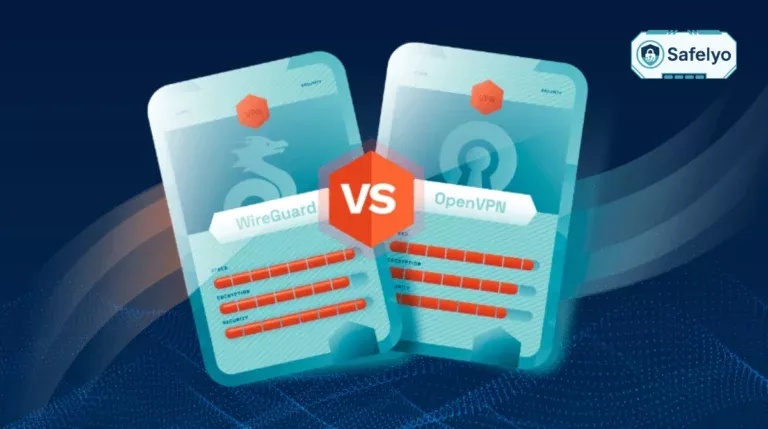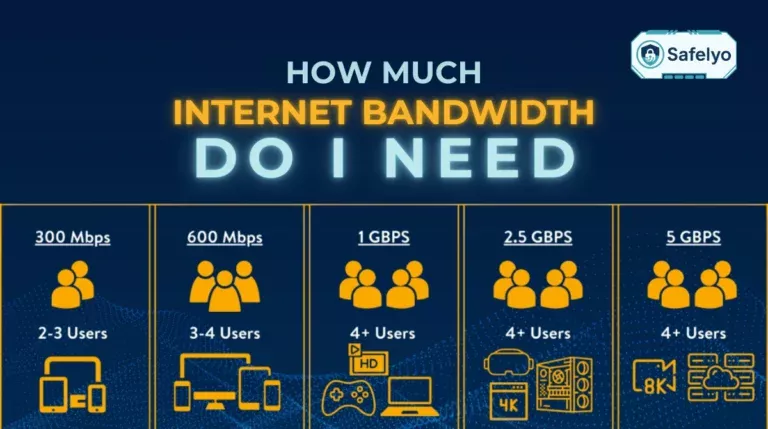You have the OpenVPN Connect app, and you’re searching for free OpenVPN servers. The goal is simple: get a secure, private connection without paying a dime. It seems like the perfect, cost-free solution to protect your online activity.
In the world of online security, however, the promise of ‘free’ can often come with a hidden, dangerous cost. Connecting to an untrusted server can be more dangerous than using no VPN at all, exposing the very data you’re trying to protect.
As a privacy advocate who has investigated countless ‘free’ services, I’ve seen how often these servers are a honeypot for data logging, malware, and other cyber threats. So, are free OpenVPN servers safe? The answer is almost always no – unless you know exactly who is running the server.
In this comprehensive safety guide, you’ll discover:
- The major security risks of using random free OpenVPN config files.
- Why volunteer-run projects like VPNBook can be dangerous.
- The safest free alternatives from trusted, audited VPN companies.
- How to set up your own private OpenVPN server for ultimate security.
Don’t gamble with your digital privacy just to save a few dollars. Let me guide you through the risks and show you the path to a free VPN connection you can actually trust.
1. The risks of random free OpenVPN servers
Before you download any .oVPN file from a random website that promises a free OpenVPN connection, you must stop and ask one critical question: Who is on the other end of this connection?
When you use a VPN, you are routing all of your internet traffic through a server owned and operated by someone else. You are placing an immense amount of trust in that operator. With a reputable, paid VPN service, that trust is earned through public audits, a clear privacy policy, and a business reputation to uphold.
With a random free server, you have none of that. It’s an act of blind faith. From my experience analyzing these services, faith is often misplaced. Here are the real, tangible risks you face.
- Aggressive Data Logging: The server operator can see and record every website you visit, your real IP address, connection timestamps, and more. Your “private” VPN tunnel instantly becomes a surveillance camera, and your data could be sold to advertisers or worse.
- Malware Injection: A malicious server owner can inject malware, spyware, or intrusive ads directly into your unencrypted HTTP traffic. You might be downloading a legitimate file, but the server adds its own malicious payload along the way.
- Man-in-the-Middle Attacks: The operator is in the perfect position to intercept your data. They can attempt to steal passwords, financial information, and personal messages, especially on any non-HTTPS websites you visit.
- Weak Security: You have no idea if the server is using modern, strong encryption or an outdated, vulnerable VPN protocol. You get a VPN icon on your screen, but it provides a completely false sense of security.
- Unreliable Performance: Beyond the security risks, these servers are often painfully slow, overcrowded with other users, and frequently offline, making for a frustrating browsing experience.
The bottom line is simple. Using a free server from a site like VPNBook or a random free OpenVPN server list means you are trusting an anonymous stranger with your most sensitive data. The potential savings are not worth the risk.
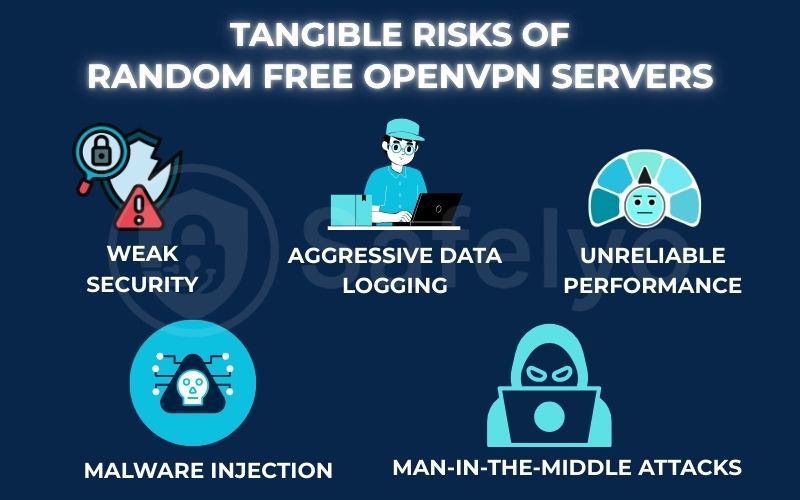
2. The safest free alternatives: Trusted privacy without the risk
So, if random free OpenVPN config files are off the table, how can you get a secure connection without spending money? Fortunately, there are several much safer alternatives. As a privacy expert, these are the only two free options I ever recommend to friends and family.
2.1. Option 1 (Best for Most Users): Use a Freemium VPN Provider
The absolute best and easiest way to get a safe, free VPN connection is to use the free tier of a reputable, independently audited VPN company.
This “freemium” model gives you the exact same powerful encryption and strict no-logs policy as their paid users. You get the full backing and transparency of a real company whose reputation is on the line. The only difference is that the free plans come with some limitations, usually on data or server locations.
- Proton VPN Free: In my opinion, this is the best overall free option on the market. It’s run by the same team behind the respected Proton Mail, is based in privacy-friendly Switzerland, and has a strict, audited no-logs policy. Most importantly, it offers unlimited data on servers in 3 countries (the US, the Netherlands, and Japan). It’s secure, private, and perfect for everyday browsing.
- Windscribe Free: Windscribe is incredibly generous with its free plan, offering 10GB of data per month (or 15GB if you tweet about them). This is a huge amount of data for a free service. You also get access to servers in over 10 countries, making it a great choice if you need more location options than Proton VPN.
- TunnelBear Free: TunnelBear is known for its incredibly easy-to-use apps and fun, bear-themed design. It’s one of the most beginner-friendly VPNs out there. The free plan is limited to 2GB of data per month, so it’s best for occasional use, like securing your connection at a coffee shop, rather than for daily browsing.

2.2. Option 2 (For Tech-Savvy Users): Create Your Own OpenVPN Server
Do you want the ultimate in control, unlimited data, and top-tier privacy for a very low cost? You can set up your own private OpenVPN server. This has become my personal preferred method for my own devices.
- What you’ll need: A cheap VPS (Virtual Private Server) from a provider like DigitalOcean, Vultr, or Linode. This will cost you around $5 per month.
- The process: It’s surprisingly easy with modern tools. You rent the VPS, connect to it via SSH, and run a single, well-known installation script (like the popular OpenVPN-install script on GitHub). This script automatically handles the entire server setup and generates your personal .oVPN configuration file for you to use with the OpenVPN client.
- The benefit: You are the only user. You control the server, you control the logs (or lack thereof), and you know exactly who you’re trusting – yourself. This is the ultimate solution for combining control, privacy, and affordability.
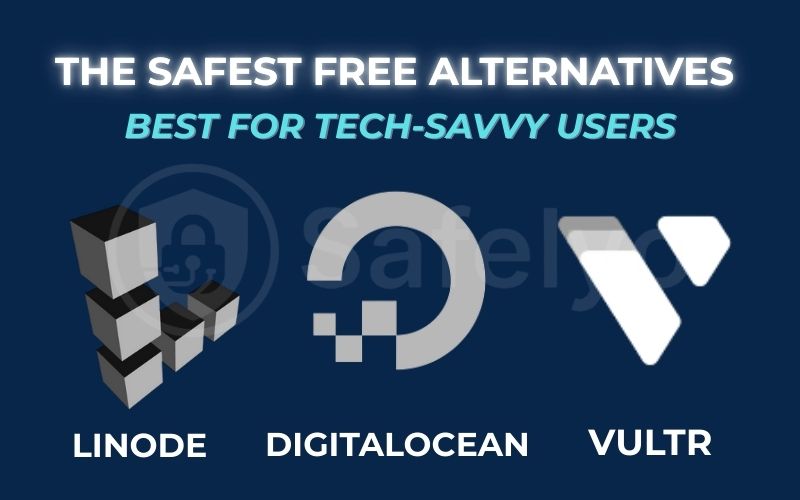
3. Volunteer-based projects (use with extreme caution)
When searching for free OpenVPN servers, you will inevitably come across two very popular names: VPN Gate and VPNBook. It’s important to understand what these services are and, more importantly, what they are not. While they can be useful in very specific situations, I never recommend them for general privacy.
3.1. VPN Gate: For censorship bypass, not for privacy
VPN Gate is a fascinating academic project from the University of Tsukuba, Japan. It’s a massive, public, and constantly changing list of VPN relay servers run by volunteers all around the world.
The Good
Because the servers are numerous and always changing, VPN Gate OpenVPN can be an effective tool for bypassing firewalls and government censorship. For someone in a restrictive country trying to reach the outside internet, it can be a lifeline.
The Bad (and it's very bad for privacy)
VPN Gate is completely transparent about its major drawback: It logs your connection data. The project’s own policy states that they log your real IP address, connection times, and the websites you visit for “research purposes” and to prevent abuse. You have zero privacy on VPN Gate.
My advice is firm: Do not use VPN Gate for torrenting, online banking, logging into personal accounts, or any other sensitive activity. It is a tool for access, not for anonymity.
3.2. VPNBook & Other Similar Sites
Sites like VPNBook occupy a riskier middle ground. They provide a handful of free OpenVPN config files along with a shared free VPN username and password that they post publicly on their website.
- The Use Case: They can sometimes work for simple tasks like bypassing a geo-block on a YouTube video.
- The Risk: They fall squarely into the “high-risk” category I mentioned in our initial warning. You are connecting to a server run by an anonymous entity. You have no way to verify their logging policies, the strength of their encryption, or the security of their servers. While they claim not to log, my professional opinion is that trusting the word of an anonymous, free provider is a gamble you should not take with your personal data.
4. How to use free OpenVPN config files (if you accept the risks)
Now that you recognize the significant risks involved, you may still choose to proceed with a public server. This is only for a non-sensitive task. If so, you’ll need to learn how to use free OpenVPN.
The process for importing and connecting with any .oVPN configuration file is the same, whether it’s from a trusted provider, your own server, or a public site. I’ve done this process hundreds of times across different devices.
Step 1: Install the OpenVPN Connect Client
First, you need the official OpenVPN app, which acts as the “car,” while the .oVPN file serves as the “key.” Download the “OpenVPN Connect” client from your device’s app store or the official OpenVPN website. It’s compatible with Windows, macOS, iOS, Android, and Linux.
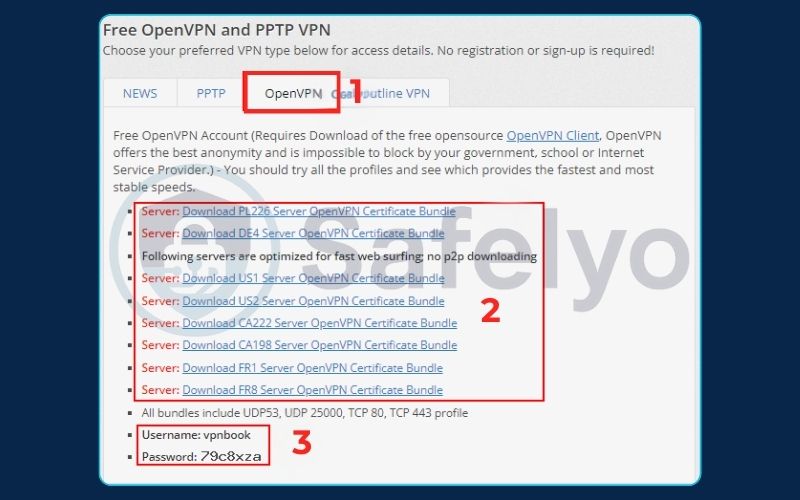
Step 2: Download the .oVPN Config File
Navigate to your chosen source (e.g., VPNBook or VPN Gate) and download the .oVPN configuration file for the server you want to connect to. Save it to a location you can easily find, like your “Downloads” folder.
Step 3: Import the File into the App
Open the OpenVPN Connect app. The interface is slightly different on desktop vs. mobile, but the process is similar:
- Look for an “Import Profile,” “File,” or “+” button.
- Select the “File” tab and browse to the .oVPN file you downloaded in Step 2.
- Select the file to import it.
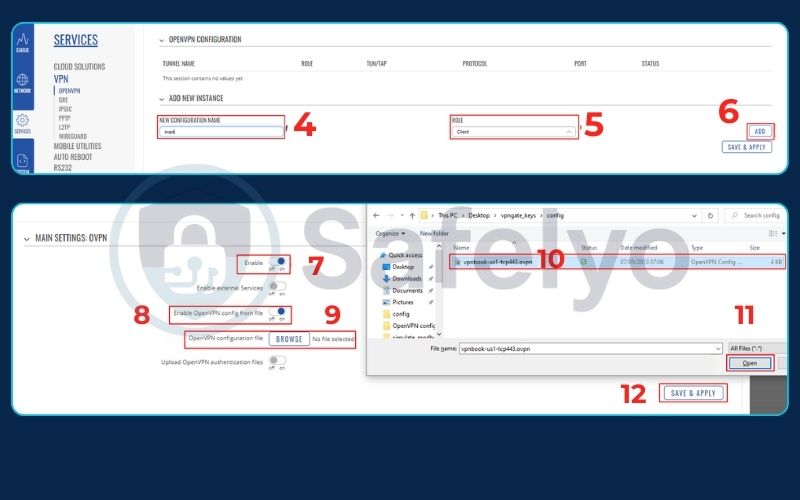
Step 4: Enter Credentials and Connect
After importing, the new profile will appear in your list.
- Tap on the profile. If the service requires a login (like VPNBook does), you’ll be prompted to enter the free VPN username and password.
- Tap the toggle switch to initiate the connection.
If the connection is successful, the app’s status will change to “Connected,” and you will see a VPN icon in your device’s status bar. Your internet traffic is now being routed through that public server.
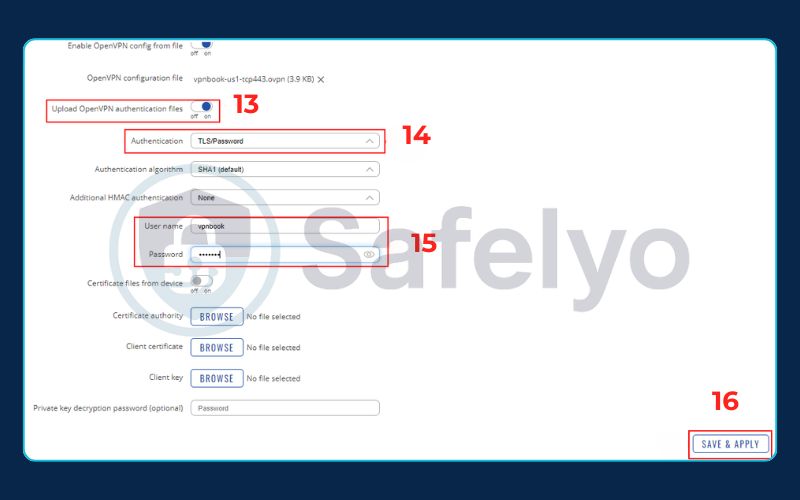
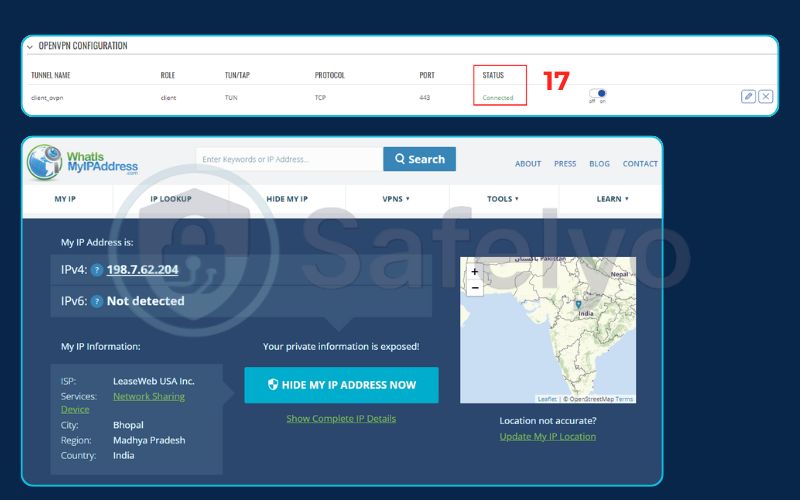
5. FAQ about free OpenVPN servers
We’ve covered the risks and the safest alternatives for a free VPN connection. Here are some quick, direct answers to the most common questions about using free OpenVPN servers.
What are the safest free OpenVPN servers in 2025?
The safest free VPN options are not public OpenVPN servers. They are the free plans from reputable, audited VPN providers. My top recommendation is Proton VPN Free because it offers unlimited data and is backed by a very strong, publicly audited no-logs policy. This is far safer than any server from a random list.
Are free OpenVPN servers safe?
Generally, no. Free OpenVPN servers from public lists like VPNBook or VPN Gate carry significant privacy and security risks. You have no way of knowing who operates the server, if they are logging your data, or if the connection is truly secure. It’s an act of blind trust that is not recommended for any sensitive activity.
Can I find an OpenVPN Connect free server in the app?
No, the OpenVPN Connect app does not provide a free server. The app is just a client – a tool to connect to a server. You must provide your own server profile by importing an .oVPN file from a third-party service, whether that’s a paid VPN provider, a freemium service, or a high-risk public server.
What is the OpenVPN Community Edition?
The OpenVPN Community Edition is the free, open-source software that allows technically skilled users to build and host their own private VPN server. This is the “Option 2” we described in the guide and is an extremely secure and cost-effective solution for those willing to set it up.
Why do sites like VPNBook require a username and password?
They use a shared free VPN username and password system to provide a basic level of access control to their public servers. This makes it slightly harder for automated bots to abuse the service and helps them manage the large number of users attempting to connect.
Are free OpenVPN servers fast enough for streaming?
Almost never. Public servers from projects like VPN Gate are typically very slow, overcrowded, and have unstable connections. This makes them completely unsuitable for streaming video, which requires a consistent, high-bandwidth connection.
6. Conclusion
While the allure of free OpenVPN servers is strong, your digital privacy is too valuable to entrust to an unknown, anonymous server operator. A secure connection requires trust, and that trust must be earned through transparency, audits, and a clear business model.
- Random free servers from public lists are not safe; they likely log your data and pose significant security risks.
- The safest free option is a freemium plan from a reputable VPN provider like Proton VPN.
- For tech-savvy users, creating your own VPN server is a cheap and highly secure alternative.
- Use volunteer projects like VPN Gate for censorship bypass only, never for privacy.
In the world of security, “free” often comes at a hidden cost – your data. Choose a trusted provider, even if it’s on a limited free plan, to ensure your internet traffic remains truly private.
Ready to step up to a VPN you can truly trust, with unlimited data and premium features? Explore the reviews of the best paid VPN services in our Privacy & Security Basics section from Safelyo to find the perfect fit.


